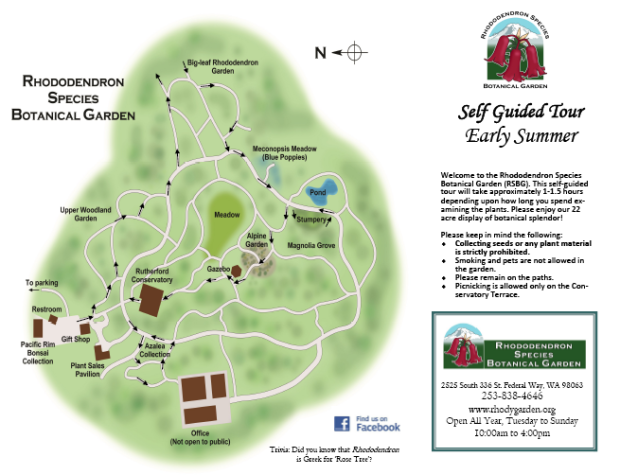Download Early Summer 2016 (SEH)
From the Visitor Center, stay to your left and, following the sign, walk to the Upper Woodland Garden which features many rhododendrons with thickly indumented leaf undersurfaces. Take the path between the two deciduous magnolia trees. The magnolia on your right is #1 Magno-lia sargentiana var. robusta from China. This pink flowering magnolia has among the largest flowers of any magnolia. This plant is fairly uncommon in cultivation despite the large flowers and nice foliage. The one on your left is #2 Magnolia hypoleuca from Japan. Its cup-shaped, creamy white, fragrant flowers appear in May, and its huge leaves grow up to one-and-a-half-feet long!
Continue along the path and you will see various kinds of woodland groundcovers including :
#3 Luzula sylvatica (Golden Wood Rush)
#4 Gymnocarpium (Oak Fern)*
#5 Ajuga (Bugleweed)
#6 Speirantha convallarioides (False Lily of the Valley)
#7 Coptis laciniata, Goldthread
#8 Primula moupinensis*
These groundcovers are suitable for shady woodland gardens. #7 Coptis laciniata is a slow-spreading groundcover that is native to the Pacific Northwest. The name comes from the golden yellow rhizomes that creep just beneath the surface of the ground. The last on the list, #8 Primula moupinensis*, is a very interesting and rare primrose from S. Sichuan, China. It is interesting and very unique because it sends out numerous runners which root when they touch the ground—just like strawberries! Pale pink flowers are produced in early spring. Follow the sign and find #9 Illicium henryi, Henry’s Anise Tree on your left right before the main path. This evergreen Chinese native has beautiful waxy reddish flowers with aromatic leaves. Unlike Star Anise (Illicium verum), the seedpods of this plant are not edible.
Pass the bamboo on your right and walk on to the narrow path on your left. This area is called the Big-Leaf Garden. Most of the big-leafed rhododendrons eventually become very large trees in their native temperate rainforests in the Sino-Himalaya. Notice the beautiful new growth of #10 Rhododendron hodgsonii* native to the eastern Himalayan Mountains. The new foliage emerges with a coating of shiny silvery indumentum, and the smooth and exfoliating bark of the older stems is also attractive.
Continue straight ahead to a large patch of #11 Podophyllum pleianthum, the Asian May Apple. This is a beautiful woodland plant with umbrella-like foliage. The plant is used medicinally in its native China. Follow the sign to enter the #12 Big Leaf Forest, where we feature some of the hardiest Big Leaf species. Here, you will find Rhododendron praestans, watsonii, kesangiae, rex, and montroseanum. In 10 to 15 years, you will be able to walk under the large rhododendron trees beneath a grove of native conifers.
You should now be veering slightly to the right and headed back toward the main path. Stay to the left and see #13 Rhododendron rex* on both sides. This plant has extremely attractive shiny deep-green foli-age with a thick gray-to-buff indumentum beneath. It has equally impressive pink to white flowers in early May. In the forests of southern China, where it is na-tive, it can attain heights of up to 45 feet. On your left, see #14 Arisaema consanguineum, Jack in the Pulpit. This is a fantastic and unusual woodland plant that is easily grown in a shaded garden.
Once back at the main path, take a left. Keep walking and on your right you will see #15 Lilium hansonii,* a native of Korea and Japan. The reflexed petals of the bright yellow-orange flowers are very thick in texture. This lily was grown from seed collected wild in Japan. Across from the lilies is #16 the Meconopsis Meadow with hundreds of Himalayan Blue Poppies*. #17 Cardiocrinum giganteum*, the Himalayan Giant Lily from the Sino-Himalaya can grow to 12-feet tall with masses of six-inch-long fragrant flowers in June. This plant is monocarpic, which means it dies after flowering. From seed, it takes 7-8 years for this lily to reach flowering size—it is worth the wait!
Keep going along the main path until you see the Hardy Fern Foundation’s Victorian Stumpery (#18) on your right. A “stumpery” is an English Victorian-period garden design that romanticizes nature. The design uses tree roots and stumps placed on their sides or upside down creating a “wild scene” which is then planted with hundreds of ferns and other woodland plants. Have a seat on the cut cedar-log bench at the top of the stumpery and enjoy the view of the pond garden.
From here, walk back along the main path toward the blue poppies and take an immediate uphill left just past the stumpery. Go up the hill and you will see #19 Rhododendron pachysanthum on your left. A native of Taiwan, this is one of the finest foliage plants in the genus Rhododendron. Indumentum color ranges from silver-white to rich brown on the upper surface. Continue up the hill to the Alpine Garden (#20). Please take some time to explore this unique garden area. Most of the plants here are found at high altitudes in the mountains of Asia. Don’t miss the beautiful specimens of #21 Rhodo-dendron campylogynum*. Walk up toward the Gazebo for a shaded break and the fine view.
Follow the signs for the self-guided tour which will take you past #22 Stewartia pseudocamellia*, a summer-flowering tree with beautiful bark. This camellia relative also has colorful fall foliage and note the beautiful exfoliating bark. Continue straight ahead to the Rutherford Conservatory where a separate self-guided tour sheet is available inside.
From the front door of the Conservatory, head back to the main path and go left to visit the Azalea Garden (#23). The mass planting of #24 Primula prolif-era and #25 Iris sibrica* ‘Caesar’s Brother’ is a stun-ning color combination. Also, don’t miss the bright orange and yellow flowers of #26 Rhododendron calendulaceum, the Flame Azalea which is native to the Appalachian Mountains of the Eastern USA where it occurs in forests and rocky openings.
From here, you can walk back to the Visitor Center where you started. Many of the plants you viewed today are available in the sales area. Most of these plants are rare in retail nurseries. We hope you enjoyed the self guided tour today. Please come back and visit the garden again.
* For sale at the RSBG Nursery

